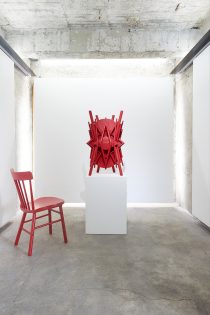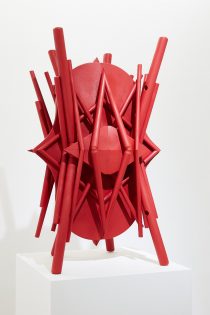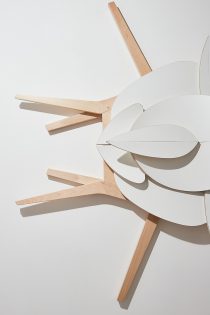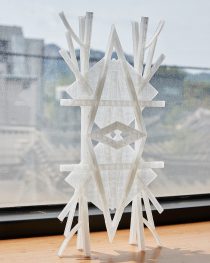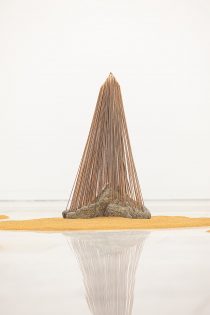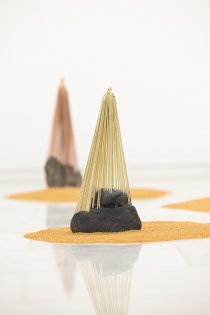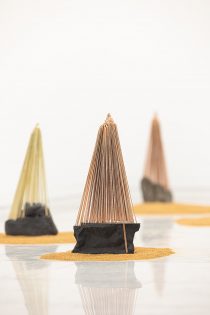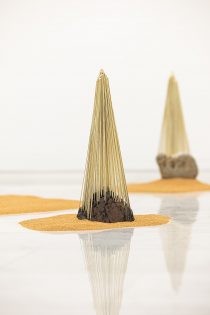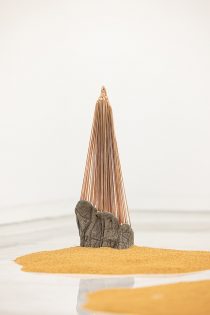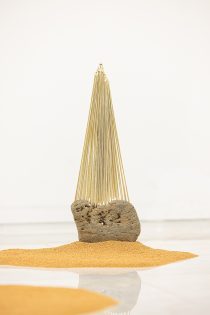Making Strange: The Parallel Lives of Cheon-Wook Park’s Objects and Images _ Rachel Gugelberger, 2012
|
Making Strange: The Parallel Lives of Cheon-Wook Park’s Objects and Images An inventory of Cheon Wook-Park’s artistic cathexis reveals an emphasis on mass-produced objects—sculpture, photography and installations that combine fabricated objects with altered ready-mades to explore visual perspective and dimensionality. “The objects say nothing by themselves,” states the artist, who creates a parallel universe for his objects through strategies of displacement. The roles these objects play are articulated in three series, each building upon divergent conceptual parameters that contemplate the reconciliation of object and space. In the series Wrapping, everyday objects are arranged and wrapped in continuous layers of cellophane until their physical characteristics are obfuscated and their functionality rendered inoperative, resulting in cocoon-like forms. In The Sunkist Cannot Stand Alone (2006), for example, a chair is wrapped until it can no longer stand, invalidating its raison d’être. (The title refers to a brand of furniture.) I will go home early (2006) evokes both great civilizations and pre-civilization in one: A bicycle is transformed into a headless, limbless combination of human and animal. Painted to resemble bronze, animal has transitioned into industrial technology without learning how to walk first. In Tapench (2006), Park wraps together a pagoda monument and bench. (The title is a portmanteau of the Korean word for pagoda, “tap,” and “bench.”) And in House Cleaning (2006), Park depicts a life-size, cartoon-like robotic figure standing atop a pedestal. Evoking modernist sculpture in its presentation, it is accompanied by x-rays that reveal the mass-produced stuff that give the figure form, such as a dust broom and rake. Exploring the central idea of perspective (derived from the Latin perspicere, meaning “to see through”), these metamorphoses ultimately subvert the distinction between object and meaning. Park’s practice is related to the techniques of defamiliarization or ostranenie (making strange). Coined by critic Viktor Shklovsky in his 1917 essay “Art as Device,” defamiliarization refers to the practice of presenting the familiar in strange ways. By extension, Jacques Derrida’s concept of différance plays on the double meaning of the French word différer, “to defer” and “to differ.” While Park indeed makes strange and defers meaning, the work in the series Silent Smile recalls early Renaissance anamorphic perspective, in which a distorted image becomes recognizable when viewed from a unique vantage point, typically by way of its reflection, a cylindrical mirror or a particular viewing angle. In Silent Smile, Park photographs sculptural tableaux placed in various sites from different vantage points. Thinking about Village (2007) is the most succinct example, and also the most deceiving upon first glance. The image consists of a street scene in single-point perspective. At the center of the composition is what appears to be a photograph on a tripod stand, depicting an aerial view of a model of the solar system above a table that stands on a floor map of the world. In fact, the seeming photograph on the stand is not a photograph at all, but a three-dimensional sculptural tableau. The rectangular photographic frame provides the conceptual parameters that limit what is made visible in the final object. That which literally “fits” into the pre-determined borders of the frame determines what is cut from the sculpture (i.e., “cropped” from view) using dimensions reduction. He then creates a stand for the object and positions it into various situations, documenting it from various vantage points. The object now exists as a 3D substitute for flatness. The source object of Sahara Goldfish (2008) is a replica of a person in a hooded-sweatshirt; face down and asleep at a desk. The object is photographed on steps, in a sidewalk planter and on the street atop a barrel. In the street scene, a circular street mirror to the right of the barrel captures the sculpture’s backside, exposing the sharp cut edges of the desk as well as the white plaster the figure is made from. In the final presentation, all three photographs are exhibited, as well as the source object. The inclusion of streaming video of the object implicates the passage of time as an active component of an object’s life. Later works in Silent Smile return again to the ready-made. In Untitled (2011), a rectangular sheet of metal is cut out of a large metal bowl, and in another Untitled (2011), a rectangular sheet of plastic is cut out of a red colander, both formally premised on the rectangular photographic frame. Situated in outdoor spaces and photographed in situ; the objects spark associations of the lowest common denominator with the environment that surrounds them and belie a fundamental disconnect with nature and function. Incorporating both reflective and porous forms that further complicate Park’s modified ready-mades, their surfaces transform each image into a visual essay on the act of looking. Invoking painterly compositions within their rectilinear window frameworks, the perspectival illusionism of Silent Smile suggests the techniques of trompe l’oeil painting, as well as set design, in which objects become props. Whereas trompe l’oeil involves realistic imagery to create optical illusions that the objects depicted exist in 3D, Park employs 3D objects–altered, fabricated or arranged–to depict the optical illusion that the objects exist in 2D. Park’s process of anamorphosis is shared by way of a trick concealed “inside” the image or via documentation that reveal how this flatness is achieved. In his most recent body of work Grow in the Middle, Park’s interest in geometry is apparent. Here he builds out from the center of a picture plane, altering mass-produced objects to express the notion of reflective symmetry. What up Somehow (2012) combines predominantly plastic objects–jerry can, watering can, and hoses, connected with industrial handles. Grow in the Middle (2012) is composed of hula-hoops, coatracks, traffic barriers, and more. Evoking the complex system of arteries or DNA molecules, the reference to the body is inescapable. Vacillating between transmogrification, anamorphosis and assemblage, Park never leaves the object alone, hence denying the possibility of an essence. Distinguishing one thing from another based on the level of distortion achieved, he underscores the extent to which imaging informs dimensionality and perspective, as well as figurative and literal ways of seeing. Rife on visual puns, light on irony and socio-economic associations, the meaning of Park’s objects plays second fiddle to his process. Yet, no matter how strange, the deliberate confusion of his objects cannot completely deny the disharmony between object and use-value. His objects may have been endowed with parallel lives; however, in pointing to both their creation and destruction, Park cannot help but draw attention back to the very world from whence they came. Rachel Gugelberger (Independent Curator) |
